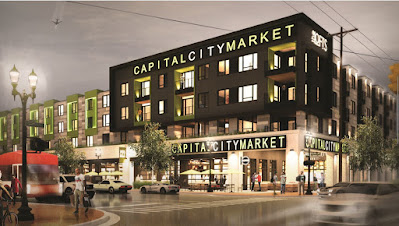With financing in place, general contractor bids are due to be submitted to developer The Community Builders on Aug. 12, according to the Dodge Reports. Site preparation work could start in November but major construction activity is likely to get under way in the spring.
The investment in the rail system along with increasing development around stations should not only boost transit ridership but also boost the fortunes of affected neighborhoods and their residents.
To be built on the site of the Buckeye-Woodland Elementary School, 9511 Buckeye Rd., is a 120-unit apartment building called Woodhill Station, named after the nearby train station. Also planned nearby, on Woodland Avenue near East 110th Street, are 77 housing units including apartments and townhomes called Woodhill Center.
The two developments represent phases one and two of the redevelopment of the 80-year-old Woodhill Homes, one of the oldest public housing properties in the nation. The two locations will offer up to 170 subsidized units for current residents of Woodhill Homes. Once they open, some Woodhill residents will be relocated to them so that the aging public housing can be redeveloped.
Earlier this year, Cuyahoga Metropolitan Housing Authority (CMHA) requested but fell just short of winning a $35 million federal grant to redevelop the Woodhill Homes. However, CMHA officials said that the project will still move forward, albeit more slowly.
More details are now publicly available about the Woodhill Station apartments. It will be a 135,000-square-foot development, rising up to five stories tall in the middle of the Z-shaped building. Estimated development cost is $33 million.
Financing includes a secured mortgage from the U.S. Department of Housing and Urban Development as well as Low Income Housing Tax Credit financing from the Ohio Housing Finance Agency, according to CMHA.
The building will have 41 one-bedroom apartments, 61 two-bedroom apartments and 18 three-bedroom apartments. It will also offer a fitness center, meeting room, community room, packages/mail room, security/fire system with cameras, rooftop deck on the west/downtown side of the building, computer lounge, youth lounge, onsite laundry and leasing office, according to planning documents filed with the city.
Additionally, Woodhill Station will have about 110 parking spaces, community terraces, raised planter gardens, fruit tree orchard and a playground. The developer will pursue a green building certification for the project.
Stephanie Anderson Garrett, vice president of communications at The Community Builders, did not respond to an e-mail seeking comment prior to publication.
The reduced number of parking spaces is due to the project's proximity to the Buckeye-Woodhill Station stop on the Greater Cleveland Regional Transit Authority's (GCRTA) Blue and Green lines between downtown and Shaker Heights.
GCRTA replaced the Buckeye-Woodhill Station in 2013 and is now replacing tracks, signals and retaining walls from near East 55th Street to Shaker Square. The current projects represent a $10 million infrastructure investment in the neighborhoods the rail line serves, according to GCRTA capital budget documents.
The investment in the rail system along with increasing development around stations should not only boost transit ridership but also boost the fortunes of affected neighborhoods and their residents.
"Ridership on GCRTA's light-rail system has plunged over 60 percent since the Great Recession of 2008 due to service cuts and fare increases," said Christopher Stocking of Clevelanders for Public Transit (CPT), a transit advocacy group.
"At the same time, over half of Clevelanders are rent-burdened, meaning they spend over 30 percent of their income on housing. Building affordable housing near frequent transit is critical after decades of redlining in Woodhill," he said, referring to the unethical practice of putting financial and other services out of reach of residents in certain areas based on race or ethnicity.
CMHA's long-range Woodhill Homes transformation plan calls for building a total of 546 new units at both the current Woodhill Homes site and in the surrounding neighborhood, with the goal of about 22 percent being market-rate. That would make about 120 total housing units market rate, leaving 426 as affordable units.
"The addition of 120 new units of affordable housing over a vacant lot is excellent without displacing Woodhill residents," Stocking added. "CPT is concerned that larger plans for Woodhill Homes would only build about 420 units of affordable housing, less than the nearly 500 units currently provided. Cleveland needs much more transit-oriented development, but it has to be done in an equitable way."
The school property hasn't sold yet for the new Woodhill Station development. That site is a couple hundred feet west of the intersection with East 93rd Street, with CMHA renderings showing a later phase of the Woodhill Station development expanding to that corner.
The property at the corner is owned by the Buckeye-Shaker Square Development Corp., an inactive community development corporation. The active CDC in that area is Burten Bell Carr Development Inc. (BBC). An e-mail to BBC's Real Estate Development Director Jeffrey Sugalski was acknowledged but not responded to, in seeking information about future development phases.
Located just east of the path of the new Opportunity Corridor Boulevard, the development site has a commanding view of the city. The structure is planned on a hillside, once called Hungarian Hill as the neighborhood was heavily populated with Hungarian immigrants before the 1970s.
The neighborhood added large numbers of African-Americans starting in the 1950s and especially in the 1960s, resulting from the Great Migration from the South. Unfortunately, many businesses moved out, taking jobs with them. That left the neighborhood's residents with fewer opportunities and declining conditions.
But there is still a small Hungarian presence here, with St. Elizabeth of Hungary Catholic Church, 9016 Buckeye, that was built over three decades and completed in 1922.
A major employer in the neighborhood is the Miceli Dairy. Although its founder John Miceli was an Italian, the bakery established its permanent home here in 1949 and employed many Hungarians, African-Americans and others. Rather than bolt for the suburbs or beyond as many other nearby factories did, the plant underwent a $20 million expansion in 2011.
END




























